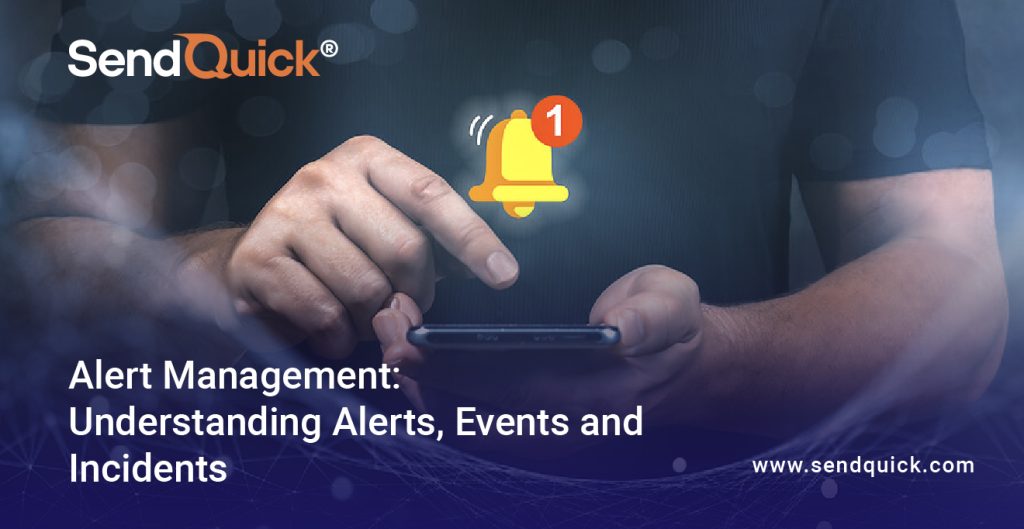As modern business systems become increasingly complex and adopt newer APIs and microservices, managing them requires a robust IT alert management system that makes the task much easier for support teams. Alerts management systems are generally deployed within IT or operations departments to allow for quick notification on current events and potential issues with how their systems and services are functioning.
Alternatively, it is also referred to as incident alerts management which enables organisations to respond to significant incidents based on vital alerts that inform teams of potential risks and threats.
In this brief overview, you may have picked up key terms such as alerts, events, and incidents, which are all important components to alert management. To better understand what they are and their role, we will go over their definition and how they are created to learn the nuances among each.
Alerts
An alert is something that warrants attention yet is not necessarily an immediate response. Its main purpose in an incident response system is to notify the right personnel to conduct further investigation on a potential issue related to the systems or services they own or support.
Alerts must occur close to or in real-time as much as possible to ensure quick resolution and maintain a low mean time to detect/diagnose (MTTD) and mean time to resolve (MTTR). They are mainly informational qualified events that the system’s predefined logic will determine if they warrant human intervention to decide if an incident is required.
Alerts are considered qualified events because they continuously collect and track data relevant to certain metrics and monitoring, like errors, latency, saturation, etc. This is in contrast to events which are only raw data independent of the context of whether they are good or bad. As such, alerts are set of qualified events deemed bad and are associated with notifications informing the technical team of the problem.
Events
An event is an occurrence or change in the regular operations of a process, network system, or workflow and may be triggered by manual input or automatically generated. They can be observed (pulled) or logged (pushed) to a system for tracking. In incident response, an event could potentially lead to an incident where IT teams need to take action to prevent that from happening or at least mitigate its effects should it occur. Individual events and transactional records concerning a particular metric (typically latency, traffic, error rate, or saturation) are the two areas where the highest volume of data is collected when monitoring.
An example of an event could be an irregular spike in CPU usage, unusually high operating temperatures in a system, 404 responses from the business website, hundreds of errors on API calls, and many other point-in-time snapshots of the state of a system. IT teams leverage this raw data to monitor system changes over time, and trigger system logic to escalate events into an alert if there is a breach in the performance threshold.
Incidents
Incidents are events that have a negative effect on an organisation and need immediate attention, such as a degraded service that must be returned to operational levels. They are typically acted on by large teams of responders, often cross-functionally, to diagnose and resolve the problem.
An important distinction is that an incident is a confirmed service degradation and thus will have higher priority for remediation than alerts. Moreover, unlike alerts, the sensitive nature of incidents means there are additional processes surrounding how the company defines the roles of first responders, stakeholder communication, and post-mortem to ensure incidents are closed as smoothly as possible.
How Alerts, Events, and Incidents Are Created
Alerts and events
Alerts and events will typically be system generated, with the former created by observability and monitoring systems that focus on various metrics related to the health of the organisation’s IT environment. When events are registered with values exceeding the established safe thresholds, the observability/monitoring tools will then push a qualified alert to the incident alert management system to notify of the breach and get attention to a predefined degradation or danger.
Incidents
As mentioned, incidents are validated degradations that impact an organisation’s revenue-generating systems, internal workforce, or customers. Although not all alerts get promoted into incidents, it is common for verified alerts to be manually promoted if they are related to a degraded service. Organisations can also set policies on when an alert can automatically escalate to an incident because of its severity.
Aside from alerts, incidents can also be created from manual reports, as there are times when there are blind spots in the organisation’s monitoring visibility and coverage. Users and customers will generate noise if they encounter a problem, prompting teams to create the incident for immediate diagnosis and remediation of the perceived degradation.
Conclusion
Alerts, events, and incidents are important components in incident response that differ significantly to the point that they need their own processes. Since not every alert becomes an incident, this distinction is key to reducing the noise and improving the reporting on the organisation’s system and service health.
Notifying the right people and avoiding alert fatigue is made much easier with our IT alert systems that boost your organisation’s response time to critical incidents. At SendQuick, we provide proven and robust IT alert and notification management solutions with comprehensive features that let your teams receive critical broadcast text (SMS) messages and alerts in real-time and via multiple channels and integrations to minimise downtime.
Besides incident notification and alerts management, our range of enterprise mobile messaging solutions includes conversational messaging mobile solutions, business process automation, secure remote access with multi-factor authentication solutions, and SMS gateway in Singapore.
To learn more, head to our solutions page or contact us to speak with a SendQuick expert.






